Ehlers-Danlos Syndrome (EDS) often goes undiagnosed or misdiagnosed because its signs—like hypermobility, chronic pain, frequent injuries, and fatigue—can resemble other common conditions. Recognizing key indicators like joint hyperflexibility, recurrent dislocations, and digestive problems can help achieve an accurate diagnosis. Early and accurate identification of EDS enables appropriate management strategies such as physical therapy, dietary adjustments, pain management, and lifestyle modifications to improve quality of life. Always consult with a healthcare professional familiar with EDS for comprehensive evaluation and personalized treatment.
Ehler-Danlos syndrome is a group of rare inherited disorders that affect the body’s connective tissues, especially the skin, joints, and blood vessels.
Connective tissues are made up of proteins and other substances that provide them with elasticity.
In people with Ehler-Danlos syndrome, the strength of collagen is affected.
Though people with Ehler-Danlos syndrome are born with the condition, it may take years before it gets diagnosed.

Dr. Grubb, a cardiologist who specializes in autonomic research and disorders, specified some signs of EDS in his speech at the Departments of Medicine and Pediatrics Health Science campus, Ohio.
*Asymptomatic hypermobility: A condition where a person's joints can move more than usual (are extra flexible), but they don't experience any pain or problems because of it.
**Autonomic test results: The outcomes from medical tests that check how well the body's automatic systems—like heart rate, blood pressure, and digestion—work.
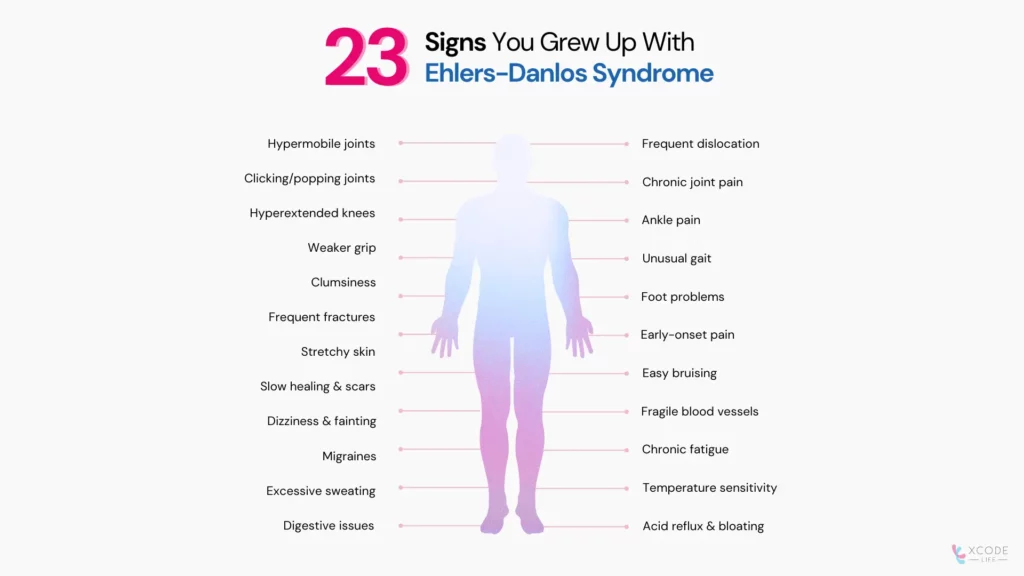
There are 13 types of Ehler-Danlos syndromes (EDS), most of which are rare.
Hypermobile EDS (hEDS) is the most common type of Ehler-Danlos syndrome.
Some symptoms of hEDS are:
There are no diagnostic tests for hEDS.
Usually, the diagnosis is based on the individual’s history, symptoms, and physical examination.
Other relatively common types of EDS are classical, vascular, and kyphoscoliotic EDS.
Ehlers-Danlos syndrome is a genetic condition. Over 20 genes have been found to be associated with EDS.
A few genes that have been associated with Ehler-Danlos syndrome are:
These genes provide instructions for making different types of collagen.
Changes (variants) in these genes may disrupt the production or processing of collagen, resulting in weak bones, skin, or other parts of the body.
This gives rise to the characteristic features of Ehler-Danlos syndrome.
Each type of EDS is caused by variants in different collagen genes.
Certain gene changes can put you at higher risk for developing many chronic conditions like diabetes, hypertension, and even scoliosis. Learning about your genetic risks can help plan prevention strategies even before the symptoms appear.
Please note: Xcode Life does not test for Ehlers-Danlos Syndrome
Ehlers-Danlos syndrome (EDS) is diagnosed through a combination of clinical evaluation, genetic testing (for specific subtypes), and exclusion of other connective tissue disorders.
EDS, Marfan Syndrome, Fibromyalgia, and Joint Hypermobility Syndrome share overlapping symptoms like joint hypermobility and chronic pain.
However, EDS is marked by fragile connective tissue, skin hyperextensibility, and frequent dislocations, while Marfan Syndrome typically includes tall stature and cardiovascular issues.
Fibromyalgia focuses on widespread pain without connective tissue abnormalities, and Joint Hypermobility Syndrome lacks the systemic features seen in EDS.
Accurate diagnosis relies on detailed clinical evaluation and genetic testing.
There is no cure for Ehler-Danlos syndrome.
Treatment is aimed at managing the symptoms and preventing further complications.
People with EDS usually have many healthcare professionals supporting their journey with the disease.
The healthcare team for EDS usually includes an occupational therapist, physiotherapist, and counselors.
Genetic counseling may help people understand their condition, how it is inherited, and the risk of passing it to their children.
*For informational purposes only. These strategies may work well for some than others. It is not advisable to start any supplements without consulting a qualified medical practitioner. A healthcare professional can provide guidance based on your unique circumstances and health profile. Always prioritize professional guidance when considering lifestyle and environmental changes.
EDS and autism demonstrate significant clinical and genetic overlaps, with emerging research highlighting shared mechanisms and comorbidities.
Both conditions may share genetic mutations affecting connective tissue and neurological development.
For instance, genes involved in collagen production (implicated in EDS) may also influence brain development, potentially contributing to autism traits.
These shared genetic factors may explain why individuals with EDS are more likely to exhibit autistic traits or receive an ASD diagnosis.
Symptomatically, both conditions share features such as:
**Proprioception is also called kinesthesia. It is the body's awareness of its position and movement in space, which is crucial for coordination and balance.
Mast Cell Activation Syndrome (MCAS): MCAS, more common in EDS, can cause flushing, GI issues, and chemical sensitivities. Some researchers are exploring whether similar immune responses occur in autism too.
EDS has some unusual symptoms that may not immediately suggest a connective tissue disorder. These include
Some people also experience digestive issues, fatigue, or even dizziness when standing up due to related conditions like POTS (Postural Orthostatic Tachycardia Syndrome).
For most types of EDS, especially hypermobile and classical types, life expectancy is normal.
However, the quality of life can be impacted by chronic pain or joint instability.
In vascular EDS (vEDS), life expectancy can be reduced due to risks like arterial or organ rupture.
Yes, EDS symptoms can evolve over time.
Joint hypermobility may decrease with age, but chronic pain, fatigue, joint instability, and early-onset osteoarthritis often increase.
Some people also develop complications like autonomic dysfunction or digestive issues later in life.
The main red flag for EDS is hypermobile joints, which move beyond the normal range.
Other signs can be a family history of connective tissue disorders, delayed wound healing, and gum fragility.
Early recognition is key, as EDS can affect multiple body systems.
EDS does not directly affect hair growth or hair loss.
However, nutritional deficiencies, common in some types of EDS due to digestive issues, may lead to hair thinning or brittleness.
Collagen supplements are sometimes recommended to support overall connective tissue health, but their effect on hair growth is not fully established.
Some people with EDS may have subtle facial features that include thin, translucent skin, a narrow nose, or high cheekbones. In certain types, like vascular EDS, skin can appear paper-thin, especially around the eyes and nose. However, facial features can vary widely, and not all individuals with EDS will exhibit these traits.
Yes, EDS can affect breast tissue. Those with hypermobile EDS experience pain from large breasts. Some studies also report rare cases of calcifications (tiny spots of calcium) in the breast tissue.
Since people with EDS have more delicate tissues, everyday activities can cause small injuries (microtrauma) to the breast tissue.
These tiny injuries can lead to a healing process that sometimes leaves behind calcium deposits.
EDS can be mistaken for other conditions that affect connective tissue, such as Marfan syndrome, Loeys-Dietz syndrome, or joint hypermobility syndrome.
Due to overlapping symptoms like chronic pain and fatigue, it may also be misdiagnosed as fibromyalgia.
Proper genetic testing and clinical evaluation by a specialist are crucial for accurate diagnosis.
Some individuals with Ehlers-Danlos syndrome (EDS) may appear younger due to specific skin characteristics associated with the condition.
People with EDS often have soft, velvety, and stretchy skin, which can give a youthful appearance.
However, this is not universally true for all individuals with EDS, as the condition can also lead to skin fragility, bruising, scarring, and other visible features such as "cigarette paper" scars or sagging skin in certain types of EDS like dermatosparaxis.
Yes, Ehlers-Danlos syndrome (EDS) is considered a chronic illness. EDS symptoms are lifelong and require ongoing management to prevent complications and improve quality of life.
Chronic pain is a common feature of EDS, affecting approximately 90% of patients, which further supports its classification as a chronic condition

Ehlers Danlos Syndrome & The Eyes
DNA testing generally doesn't hinder your ability to claim health insurance due to legal protections like GINA and GDPR that keep your genetic information private. While life and disability insurers may sometimes consider genetic risk factors or family history, most health policies focus on current health status. Your genetic data remains secure—read on to learn more about how your rights are protected.
DNA testing, also called genetic testing, helps identify changes in an individual’s genes, chromosomes, and proteins in the body.
This test uses a sample of your blood, hair, skin tissue, or amniotic fluid to help confirm or rule out a genetic condition.
DNA testing also helps determine one’s risk of developing or passing a genetic disorder, health predispositions, and ancestral and lifestyle traits.
DNA testing can be broadly grouped under two categories: Direct-to-consumer (DTC) and medical-grade tests.
These are at-home test kits that help in DNA analysis using a simple saliva or cheek swab sample.
The individual must send the sample to the lab.
Once the lab receives the sample, it provides personalized reports on potential health risks, nutritional status, and even traits related to sleep and skin health.
DTC DNA testing is convenient and offers valuable information at affordable costs.
However, they may not always provide a complete picture of one’s health without the help of a medical practitioner.
These include prenatal testing, diagnostic testing, carrier testing, newborn screening, and preimplantation screening.
DNA testing is a helpful tool for medical professionals and is also increasingly accessible to individuals, giving them valuable insights into their health risks.
However, insurance companies may also consider genetic information to determine insurance premiums and coverage.
Having a genetic marker for a disease does not guarantee the individual will develop a medical illness.
However, an insurer may interpret it as an increased likelihood of a future health condition.
The use of genetic information as a pre-existing condition depends on local laws and policy terms.
Today, with genetic testing becoming increasingly accessible, it is more important than ever to safeguard your genetic information.
Several laws are used globally to keep genetic data private and prevent its unfair use against individuals. Let’s look at them briefly.
Genetic Information Nondiscrimination Act (GINA) is a U.S. law that prevents health insurers and employers from using genetic information to discriminate against individuals.
The General Data Protection Regulation (GDPR) offers strong privacy protections for genetic data in the European Union. It does so by:
The Genetic Non-Discrimination Act (GNDA), enacted in 2017 in Canada, protects individuals from discrimination based on their genetic information.
This law prohibits employers and insurance companies from requesting or requiring genetic testing or information as a condition for providing services, including employment and insurance.
While it protects against discrimination in many areas, it does not cover situations where genetic information is used in cases involving existing health conditions or already present risks.
In Australia, genetic data is considered sensitive personal information under the Privacy Act 1988, and the Australian Privacy Principles (APPs) govern its use.
The law restricts collecting, using, and disclosing sensitive data, including genetic information.
Individuals must consent to using their genetic data, and organizations must take reasonable steps to protect this information.
However, there are exceptions, especially in research or public interest cases.
Australia’s genetic data protections may not extend to the private insurance sector, as insurers sometimes request genetic information for policy underwriting.
In most countries, there are no laws requiring citizens to share their genetic test results, regardless of the type of test.
Some healthcare insurance policies require individuals to share their family history for certain diseases or disabilities.
However, none make it compulsory to share genetic test results.
Even without DNA testing, many insurers evaluate an individual’s risk for health conditions using medical history, routine tests, and family history.
Despite the accessibility to genetic testing, a large section of the population does not willingly opt for it.
This may have to do with several misconceptions shrouding genetic testing.
Here are a few myths!
If you are keen on taking a genetic test, here are a few ways to protect your genetic privacy:
We recommend consulting a genetic counselor after taking a DNA test. They will help you decode your results and evaluate your risks for medical conditions or traits.

Genetic test results are largely protected and securely stored by most service providers.
You can rest assured that most insurers do not use DNA data against policyholders. Many insurance companies prioritize your actual health status over genetic predispositions.
Laws in several countries, such as GINA and GDPR, safeguard your rights and ensure your genetic information remains secure.
Do not let your fears and prevailing myths influence your wish to get a DNA test.
Genetic testing is an excellent way to stay informed and know more about your health, traits, and lifestyle factors.
In most countries, health insurers cannot use genetic test results to deny coverage or adjust premiums. Laws like GINA (U.S.), GDPR (Europe), and Canada’s Genetic Non-Discrimination Act protect against such discrimination. However, life and disability insurers may consider family history, so checking policy details is important.
Thankfully, insurance companies cannot access your DNA test results without your consent.
However, it is important to read and review the privacy policy of the test company.
Possibly. Unlike health insurance, life and disability insurers can consider genetic risk factors in some regions. Some countries have regulations preventing insurers from using genetic information, but others allow it under certain conditions. Always check with your insurance provider before applying for a policy.
Yes! Most health insurance policies do not factor in genetic test results. For life insurance, the impact depends on the insurer’s policies and country regulations. Discussing concerns with a licensed insurance expert before taking a test is always a good idea.
Not all DNA testing services offer the same level of data protection. Look for companies like Xcode Life that:
It is important to note that not all DNA testing services offer the same level of data protection or privacy.
This is why we recommend you look for companies like Xcode Life that:
The MTHFR gene plays a crucial role in methylation—a biochemical process essential for DNA function, detoxification, and overall health. Mutations in the MTHFR gene, particularly C677T and A1298C, can impact how efficiently the body processes folate and regulates homocysteine levels, potentially influencing health risks such as cardiovascular disease, neurological conditions, and pregnancy complications.
However, having an MTHFR mutation does not automatically mean you will develop health issues. Many individuals with these mutations live normal, healthy lives, and the risks associated with MTHFR variations can often be managed through dietary adjustments, lifestyle changes, and targeted supplementation.
Genetic testing provides actionable insights that empower individuals to make informed health decisions. However, MTHFR testing is not a diagnostic tool—it should be used alongside medical guidance for a holistic approach to health. If you suspect you may have issues related to methylation or elevated homocysteine levels, consult a qualified healthcare provider for personalized recommendations.
By leveraging genetic insights and making evidence-based lifestyle modifications, you can take proactive steps toward optimizing your well-being and preventing potential health risks.
The MTHFR (methylenetetrahydrofolate reductase) gene provides instructions for producing the methylenetetrahydrofolate reductase enzyme.
This gene is crucial for the optimal functioning of the methylation cycle.
The methylation cycle is a crucial biochemical process in our bodies. It involves adding a small chemical group called a methyl group to DNA, proteins, and brain chemicals.
This process plays a significant role in regulating many bodily functions, including gene expression, which determines how genes are turned on or off.
The MTHFR enzyme plays a particular role in converting inactive folate (5,10-methylenetetrahydrofolate) into the active form called 5-methyltetrahydrofolate so the body can use it.
Active folate helps with the conversion of a harmful amino acid called homocysteine to methionine, another amino acid that is safe and useful for the body.
If the MTHFR enzyme doesn’t work well, homocysteine can build up in the body.
This has been associated with several health conditions like:
The MTHFR gene produces an enzyme essential for the methylation cycle, which regulates gene expression and various bodily functions. Proper functioning of this enzyme helps convert inactive folate into its active form, aiding in converting harmful homocysteine into safe methionine. Dysfunctions in MTHFR can lead to elevated homocysteine levels, increasing the risk of health issues like heart disease, cancer, and stroke.
Our DNA looks like a string of letters. The 4 letters (A, T, G, and C), called nucleotides, are organized in a particular way.
For example, position one should be G, position 2 should be A, position 365 should be C, and so on and so forth.
A mutation is any change that occurs in this predefined DNA sequence. It can either affect one letter or a string of letters.

Mutations in the MTHFR gene can result in lower levels of or less functional MTHFR enzyme.
People with MTHFR gene mutations may have high levels of homocysteine and low serum folate levels.
Many mutations occur in the MTHFR gene.
But two of the most common mutations whose effects on enzyme levels and health have been studied are:
| C677T | ||||
| rsID | Major allele | Minor (risk) allele | Normal Amino Acid | Substituted Amino Acid |
| rs1801133 | C | T | Alanine (Ala) | Valine (Val) |
| All enzymes in the body require some heat to function. In the MTHFR gene, at the 677th position, if the C allele is substituted by T, it results in the production of the MTHFR enzyme, which is more sensitive to heat. As a result, it doesn’t bind well to vitamin B2, a co-factor necessary for normal MTHFR functioning. Hence, the C677T mutation results in a less functional MTHFR enzyme. (Ref) |
| A1298C | ||||
| rsID | Major allele | Minor (risk) allele | Normal Amino Acid | Substituted Amino Acid |
| rs1801131 | A | C | Glutamate (Glu) | Alanine (Ala) |
| Those with the C allele exhibit reduced activity of the MTHFR enzyme; there’s no clear mechanism explaining this reduction. The effect of A1982C on homocysteine levels is still unclear. (Ref) |
MTHFR gene mutations, particularly the C677T and A1298C variants, are relatively common across various populations worldwide.
We all inherit two copies of the MTHFR gene, one from each biological parent. So, you can have the following possible combinations:
| C677T | ||
| TT | ~80% reduced MTHFR enzyme activity | High risk for higher homocysteine levels |
| CT | ~35% reduced MTHFR enzyme activity | Moderately high risk for higher homocysteine levels |
| CC | Normal enzyme activity | Likely normal homocysteine levels |
| A1298C | ||
| CC | Reduced MTHFR enzyme activity | Moderately high risk for higher homocysteine levels |
| AC | Moderately reduced MTHFR enzyme activity | Moderately high risk for higher homocysteine levels |
| AA | Normal enzyme activity | Likely normal homocysteine levels |
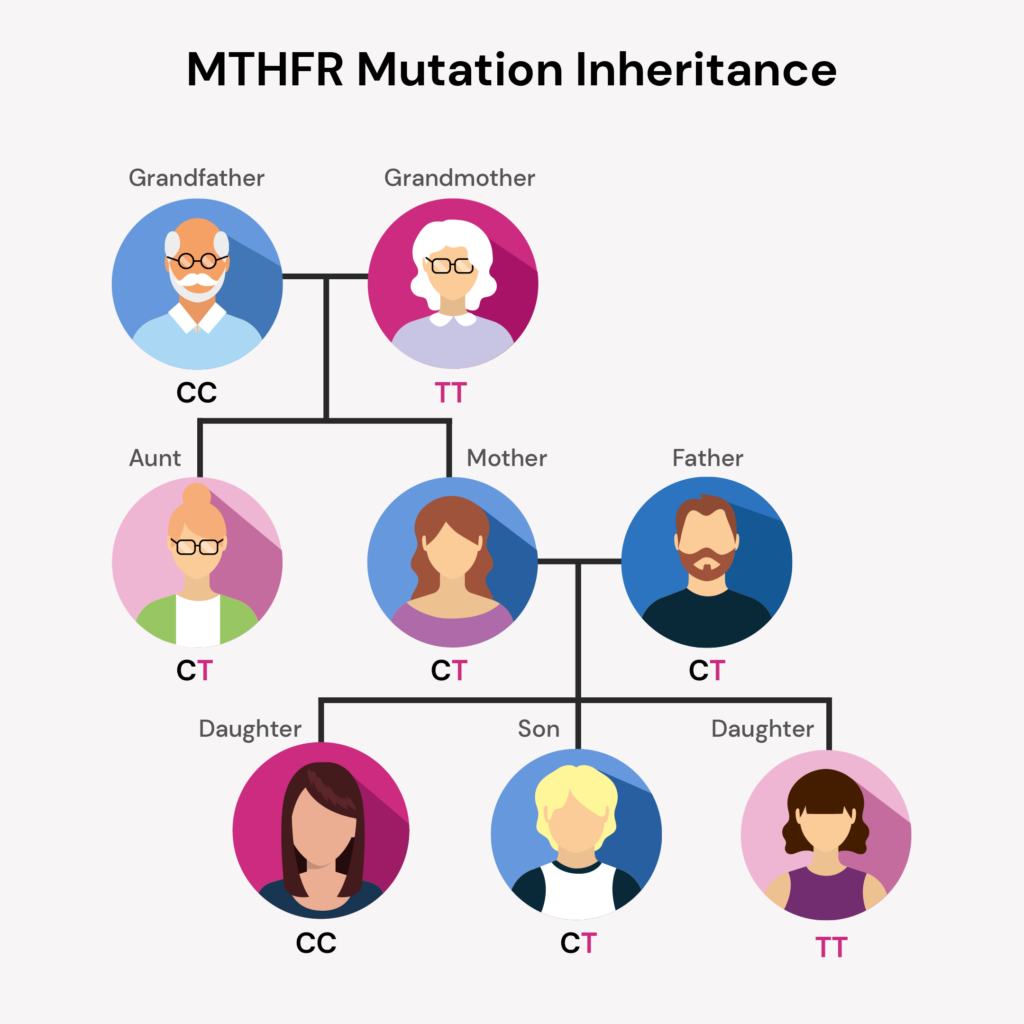
MTHFR gene mutations may lead to vitamin deficiencies, especially vitamin B9, and increased homocysteine levels.
Both of these can increase the risk for several health conditions.
A large meta-analysis involving over 40 studies found that individuals with the TT genotype (C677T mutation) have a higher risk of developing cardiovascular diseases due to elevated homocysteine levels, which is a known risk factor for heart disease and stroke.
When the body doesn’t have enough folate or the enzymes responsible for processing folate don’t work efficiently, it can disrupt an important process called the remethylation pathway.
This pathway helps keep homocysteine levels in check. If folate levels are low or the enzymes are not working properly, homocysteine builds up in the blood.
High homocysteine levels have been linked to an increased risk of certain cancers.
Folate is crucial for proper cell division and development during pregnancy.
Insufficient levels may disrupt the normal processes that help close the neural tube in a developing fetus, increasing the likelihood of NTDs.
Therefore, females with this genetic variant may need to ensure adequate folate intake, especially during the early stages of pregnancy, to help mitigate the risk of NTDs.
MTHFR enzyme helps convert homocysteine to methionine.
Our bodies then use methionine to help produce brain chemicals like dopamine and serotonin.
These brain chemicals, also called neurotransmitters, need to be at optimal levels for normal brain functioning.
Mutations in the MTHFR gene may disrupt the neurotransmitter imbalance. This can result in an increased risk of an array of conditions like:
Vitamin B12 deficiency, improper folate metabolism and homocysteine imbalance are common with MTHFR mutations.
They have been identified to play a role in the pathology of several autoimmune diseases, including psoriasis, multiple sclerosis, Behcet's disease, ankylosing spondylitis, and Graves' disease.
This could be due to:
Scientists are still researching the possible symptoms of MTHFR gene mutations.
These are some common symptoms that seem to affect many people with this condition.
Some signs and symptoms of those with MTHFR gene mutations include
Mutations in the MTHFR gene can affect children in various ways.
Common symptoms include:
MTHFR mutations are detected through genetic testing, which analyzes variations in the MTHFR gene—primarily C677T and A1298C.
These mutations can impact folate metabolism, methylation, and homocysteine levels, influencing overall health.
*MTHFR testing is not a diagnostic tool and should not be used to self-diagnose medical conditions. While certain genetic variations may influence methylation and folate metabolism, they do not necessarily lead to health issues. If you are experiencing persistent symptoms or have concerns about your genetic health, consult a qualified healthcare professional for proper evaluation, guidance, and personalized recommendations.
MTHFR testing is available through:
Understanding your MTHFR report is key to making informed decisions about your health and wellness.
Let’s break down the contents of a typically delivered MTHFR report.
Most services analyze the 2 main variants in the MTHFR gene: C677T and A1298C.
| Possible Results | ||
| Normal | No mutations detected | Likely no effect |
| C677T Heterozygous | One copy of the variant allele - CT | Moderately lower folate levels and higher homocysteine levels |
| C677T Homozygous | Two copies of the variant allele - TT | Lower folate levels and higher homocysteine levels - associated health risks |
| A1298C Heterozygous | One copy of the variant allele - AC | Moderately lower folate levels and higher homocysteine levels |
| A1298C Homozygous | Two copies of the variant allele - CC | Lower folate levels and higher homocysteine levels |
| Compound Heterozygous | One copy of each mutation - C677T: CT and A1298C: AC | Lower folate levels and higher homocysteine levels |
While MTHFR is an important gene in the methylation cycle, there are also other genes that are a part of the normal methylation process.
That’s why Xcode Life has developed the industry’s most comprehensive methylation panel with 15 genes and 64 variants, including MTHFR, MTRR, MTR, COMT, and AHCY.
You can simply upload your raw DNA file from ancestry tests provided by companies like 23andMe, Ancestry DNA, FTDNA, and My Heritage to get your reports in <24 hours.
Adopting targeted lifestyle changes can help manage the effects of MTHFR mutations, support healthy methylation, and reduce associated health risks.
Below are evidence-based strategies to optimize your diet, supplements, and daily habits.
Foods to eat:
Foods to avoid:
Since MTHFR mutations affect the way the body processes certain vitamins, one of the important ways of handling the condition is nutritional supplementation.
Folate vs. Folic Acid For MTHFR
Folate is the naturally occurring form of vitamin B9, and folic acid is the synthetic form added to fortified foods and supplements.
Individuals with MTHFR mutations have a reduced ability to convert folic acid into its active form, 5-methyltetrahydrofolate (5-MTHF), which is the form the body can readily use.
Research indicates that 5-MTHF increases plasma folate more effectively than folic acid, regardless of MTHFR mutations.
Magnesium: While the MTHFR mutation does not cause magnesium deficiency, this mineral may help reduce cardiovascular risk in people with this gene mutation.
It is not advisable to start any supplements without consulting a qualified medical practitioner. Not everyone with MTHFR mutations may require supplementation, as individual health needs can vary significantly. A healthcare professional can provide guidance based on your unique circumstances and health profile. Always prioritize professional guidance when considering dietary changes or supplementation related to MTHFR mutations.
Environmental toxins, heavy metals, and pollutants can significantly impact the body's methylation processes, particularly in individuals with MTHFR gene variations.
According to a 2021 study, exposure to metals like manganese, arsenic, lead, mercury, nickel and cadmium can lead to epigenetic modifications, including DNA methylation. These epigenetic alterations may contribute to the development of neurodegenerative diseases such as Alzheimer's, Parkinson's, and Huntington's disease.
A metapredictive analysis revealed that air pollution level was significantly associated with MTHFR 677 TT polymorphism-mutation and an increased trend toward breast cancer risk.
The MTHFR enzyme is thermolabile (deactivated by heat) and its activity may be further reduced in individuals with polymorphisms as environmental temperatures rise due to global warming exacerbated by air pollution.
Air pollutants potentially affect MTHFR gene expression through genotoxicity and epigenetic modifications, leading to changes in DNA methylation patterns.
This interaction between genetic factors (MTHFR polymorphisms) and environmental exposures (air pollution) appears to influence breast cancer susceptibility.
The associated risk and polymorphism rate varies by geography.
Heavy metals such as lead, mercury, cadmium, and arsenic are particularly harmful to individuals with MTHFR mutations.
These metals can interfere with enzymatic processes critical for detoxification and methylation.
They may bind to enzymes or disrupt cellular functions, leading to an accumulation of toxins in the body.
This accumulation can further impair the already compromised detoxification pathways associated with MTHFR mutations.
Elevated levels of heavy metals have been linked to increased susceptibility to autoimmune conditions and chronic diseases.
However, while some studies suggest that people with MTHFR mutations might be more vulnerable to these toxins, this remains an area of active research and should be interpreted cautiously.
To support detoxification pathways in the presence of MTHFR mutations, consider the following strategies:
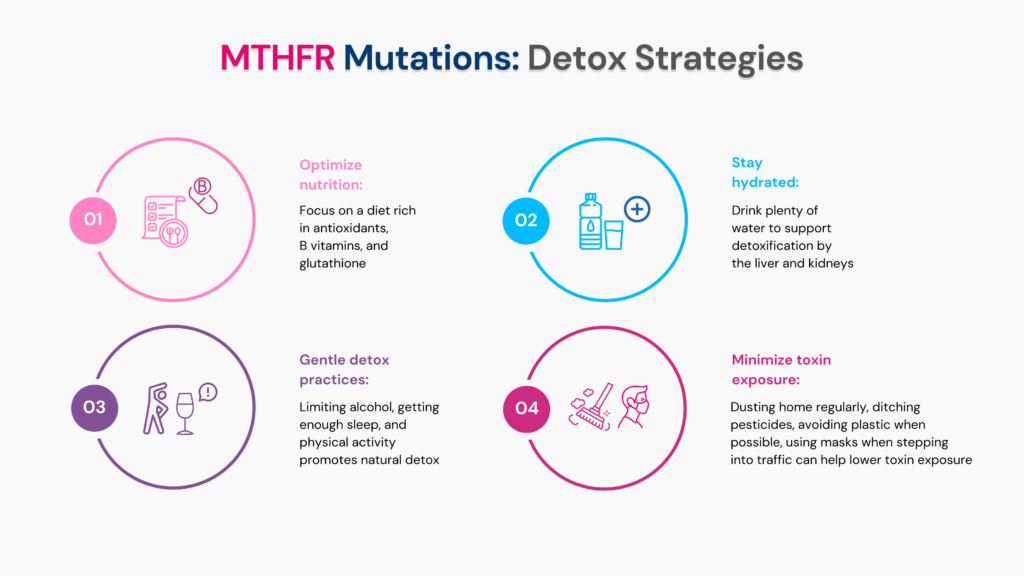
Managing MTHFR mutations effectively requires a personalized approach that considers individual genetic profiles, lifestyle factors, and health goals.
The first step in personalized MTHFR management is to understand your specific genetic variations.
Genetic testing can reveal whether you have common mutations such as C677T or A1298C, which can influence how your body processes folate and regulates homocysteine levels.
Other than MTHFR, several genes like MTR, MTRR, COMT, and AHCY affect the methylation process. So, they need to be included in the test as well.
Based on your methylation status, dietary recommendations can be tailored to include foods rich in natural folate and other B vitamins that support methylation.
Avoiding synthetic folic acid in favor of methylfolate may also be advised.
While some individuals may benefit from supplements like methylated folate or B vitamins, others may not require additional supplementation.
In some cases, additional supplementation with vitamin D or NAC may be required.
A healthcare provider can help determine the right approach based on your unique needs and health status.
Along with this growing interest in MTHFR, there's a wave of misinformation that can easily lead to confusion and unnecessary worry.
Here are some common misconceptions surrounding MTHFR and Methylation
Fact: MTHFR isn't the only gene associated with homocystinuria.
In fact, another gene called CBS has a stronger association.
Only extreme situations lead to a full-blown mutation, and the detection of an MTHFR variant on a report isn’t necessarily a cause for concern.
Fact: While it’s true that a mutated MTHFR enzyme can’t act upon folates effectively, it’s also important to understand that your body has other ways of handling folates.
The folate level in your blood is more dependent on your folate intake than your MTHFR mutation.
Fact: Birthmarks like stork bites, sugar bugs, and sacral dimples could spook parents into worrying about the health of their infants.
However, they aren’t a cause for concern since they fade away as time passes.
Additionally, no studies have been published that show any correlation between these birthmarks and the adverse effects of the MTHFR mutation.
Fact: In most cases, no. Even a double C677T mutation only lowers folic acid levels by 16%.
Folic acid levels also depend on various factors like diet and environmental exposure.
If the labs don’t indicate a severe deficiency, adding extra vitamin B9-rich foods to your diet should do the trick.
Xcode Life offers a comprehensive MTHFR test that provides insights into the methylenetetrahydrofolate reductase (MTHFR) gene, which is crucial for understanding methylation processes in the body.
Unlike many other services, Xcode Life’s report also includes insights into 14 other methylation genes, including MTR, MTRR, COMT, and AHCY and 66 genetic variants.
Further, it is available at an industry's lowest price of $50 $30.
Xcode Life distinguishes itself by allowing users to upload raw genetic data from other testing services, enabling a more detailed analysis of their genetic predispositions and health risks.
Xcode Life prioritizes user privacy, ensuring that personal data is secure and not shared with third parties.
By choosing Xcode Life for MTHFR testing, individuals can gain valuable insights into their genetic health, enabling them to take proactive steps toward optimizing their well-being.
Genetic testing is a very important piece that completes the health puzzle.
We have over 20,000 genes and millions of variants in these genes, each exerting its effect on the body - either singularly or in combination.
While the effects of some variants are immediately visible - like eye color or hair texture - many effects, like disease risk, nutrient deficiencies, and food allergies, may not be apparent.
A genetic test throws light on all these traits, helping us see the whole picture of health.
It helps us make informed decisions to alleviate health risks and even prevent certain chronic conditions.
The significance of MTHFR mutations can vary widely among individuals. Many people with MTHFR mutations live healthy lives without any noticeable symptoms or health risks.
However, these mutations can be a risk factor for folate deficiency, which may lead to various health issues if left untreated.
Dr. Graham Dersnah, an Obstetrics & Gynecology (OBGYN) chief resident, explains in a video on his YouTube channel that untreated folate deficiency in pregnant people can increase the risk of neural tube defects in the baby.
These defects affect the spinal cord and the nervous system with varying severity.
He also mentions that even in those who are not pregnant, folate deficiency can lead to anemia, fatigue, weakness, glossitis (swelling of the tongue), and diarrhea.
Absolutely, many individuals with MTHFR mutations lead normal, healthy lives.
While some may experience health challenges related to elevated homocysteine levels, lifestyle modifications such as a balanced diet rich in folate and appropriate supplementation can mitigate these risks.
Regular monitoring and working with healthcare providers can also help manage any potential complications.
Individuals with MTHFR mutations should be mindful of their diet.
Refined grains and fortified foods contain the synthetic form of folate, which individuals with MTHFR deficiency may struggle to process.
It is advisable to limit processed foods and those high in refined carbohydrates, as they may contribute to inflammation.
Alcohol can increase oxidative stress on the body and interfere with folate and vitamin B absorption.
So, it is best to limit alcohol consumption if you have MTHFR mutations.
Currently, there is no way to reverse an MTHFR mutation itself, as it is a genetic change.
However, its effects can be managed through dietary adjustments, lifestyle changes, and supplementation with B vitamins (particularly folate) to help lower homocysteine levels.
Consulting with a healthcare professional can provide personalized strategies for managing the implications of an MTHFR mutation.
Understanding your MTHFR status offers a window into how your body processes vital nutrients and manages detoxification, helping you pinpoint areas for improvement. While a mutation doesn't seal your health fate, it does highlight where targeted dietary and lifestyle changes can make a real difference. Xcode Life’s industry-best and comprehensive MTHFR and Methylation Report provides insights into 15 methylation genes to optimize your well-being. Ready to take a proactive step toward personalized health? Upload your raw DNA and get your report today!
Ever feel like you're working hard at the gym but not seeing the results you want? Or maybe you're just starting out and don't know where to begin. Your genes might hold some of the answers. DNA fitness tests can reveal how your body is wired for exercise and diet, helping you train smarter, not harder. They offer a peek into your genetic makeup, helping you tailor your training and nutrition for better results.
DNA testing for fitness analyzes specific genes linked to your physical fitness.
The test is usually done by collecting a sample of your saliva or a swab of your cheek.
You can receive personalized diet and exercise recommendations based on your genetic profile based on your genetic profile.
DNA testing for fitness can provide insights into your aerobic capacity, muscle fiber type, recovery time, nutritional needs, and more.
Genetic factors can account for 30 to 80 % of the variation among individuals regarding athletic performance.
The ACTN3 gene codes for alpha-actinin-3, a protein found in fast-twitch muscle fibers. Variations in this gene can influence muscle composition in individuals, impacting performance and fitness levels.
Several other genetic markers, such as the BDNF, TP53, and GRIN2B genes, can influence one's body's endurance, recovery, and injury risk.
DNA tests can provide a personalized approach to fitness by identifying these genetic markers.
Skeletal muscle is an important factor that affects fitness and athletic performance.
There are two types of muscle fibers in the skeletal muscles: slow-twitch muscle fibers and fast-twitch muscle fibers.
Slow-twitch muscle fibers take longer to contract but can keep working without tiring for a long time.
On the other hand, fast-twitch muscle fibers contract quickly and get tired easily.
Slow-twitch muscles enable endurance activities, while fast-twitch muscle fibers help in sprinting and other activities that need strength.
Some people can have more slow-twitch muscle fibers, while others can have more fast-twitch muscle fibers.
Apart from muscle composition, these are some other key factors where genetics can influence your fitness levels:
Based on the results of your DNA fitness test, it is possible to fine-tune your workout to achieve the best possible results. Below are some avenues that can be optimized using your DNA test results:

Science-backed fitness insights curated by experts to bring you the latest research findings on sports genetics.
Strength or cardio? Shorter or longer rest periods? How to sidestep sports injuries? Do I have optimal VO2 max? Is my cardiac output up to par?
Answers to these and more on your Gene Fitness Report.
Here are a few things to keep in mind before choosing a DNA fitness test:
Here are some popular DNA fitness tests:
| Comparing Different DNA Fitness Testing Companies | |||||
| Company | Price | Number of genes analyzed | Turnaround Time (TAT) | DNA Kit Provided? | Sample Report |
| Xcode Life | $30 (industry lowest) | 162 | < 24 hours | No new kit needed – upload raw DNA data from services like 23andMe, Ancestry, etc. | Gene Fitness |
| Genetrack Biolab | $249 | 16-20 | Not specified (could be 4-6 weeks) | Yes – sample collection kit provided | Not provided |
| Dynamic DNA Laboratories | $149 | N/A | Not specified (could be 4-6 weeks) | Yes – sample collection kit provided | Not provided |
Your genes influence your fitness and athletic performance.
DNA testing can help you identify these genetic variations and better understand what works for you.
It can help you have a more personalized and nuanced approach to fitness.
However, genetics are only one piece of the puzzle.
Your fitness levels also depend on lifestyle, training, and diet.
A combination of genetic testing, along with a healthy diet and lifestyle, will maximize your fitness potential.
Explore Xcode Life's fitness DNA test to personalize your workout journey.
Our DNA test is easy to use and profiles genes that influence endurance, performance, aerobic capacity, power, strength, and other fitness attributes.
DNA tests can provide valuable insights into your genetic predispositions.
They can tell you about your muscle composition, endurance, and aerobic capacity.
Based on these parameters and under the guidance of a professional, you can create a personalized workout regimen that best suits your body.
Such a routine will help you determine whether you are more suited to cardio or strength training, how much recovery time you need, and how you can prevent injuries.
However, genetics is just part of the picture.
Your diet, training, and lifestyle all greatly influence your fitness levels.
Combining your genetic test results with a healthy diet and lifestyle will help you achieve optimum results and meet your fitness goals.
Fitness DNA tests can provide accurate data about your genetics and help you understand how they impact your health.
However, these tests cannot guarantee you specific results.
Fitness and athleticism depend as much on your environment and diet as genetics.
While DNA tests can predict your biological inclinations, your fitness levels ultimately depend on your overall lifestyle.
There are no scientific studies to show that DNA testing can help you lose weight and become more fit.
There seems to be no difference in weight loss between people who follow a standard diet and those who follow a diet based on their genotype.
There are no downsides to fitness DNA testing from a health point of view.
However, these tests can give complex results that might be difficult for laypeople to interpret.
This can result in misinterpretation and inappropriate training and dietary choices.
Overemphasizing genetic test results also misses the bigger picture.
Your fitness levels are impacted by diet and lifestyle apart from genetics.
Focusing on genetics alone can result in a false sense of determinism.
https://pmc.ncbi.nlm.nih.gov/articles/PMC3993978
As the scientific community continues to unlock the mysteries of the human body, more and more people are turning to DNA tests to learn about their health and ancestry. While the price of a DNA test can vary depending on the type of test and the company you choose, this guide will give you an idea of how much you can expect to pay for a DNA test.
The cost of DNA tests varies widely based on the type. Ancestry tests typically range from $59 to $119, with MyHeritage offering the cheapest option at around $36. Health and wellness assessments cost between $100 and $640, with Xcode Life providing reports starting at $30. Paternity tests range from $130 to $200 for at-home options and $300 to $500 for legal tests. Molecular genetic tests can vary from $100 to $2000 depending on complexity. Overall, prices reflect a broad spectrum depending on the specific test and provider.
Depending on the type and complexity, a DNA test price may vary between $99 to more than $2000.
In some cases, additional testing may be required, increasing the cost.
In some states, insurance covers a portion of certain types of genetic tests.
From the date of sample collection, the results may be ready within a few days to a few weeks.
The turnaround time is much quicker if the genetic test is crucial for timely diagnosis (such as prenatal tests).
Different types of genetic tests investigate different things and are priced accordingly.
Let’s have a look at some important types of genetic tests.
| Type of Test | Average Cost |
| Ancestry Test (direct-to-consumer) | $59-$119 |
| Health and Wellness Assessment (direct-to-consumer) | $100-$640 Xcode Life’s Special Price: starting from $30 |
| Paternity Test | At home: $130-$200 Legal: $300-$500 |
| Molecular Genetic Tests | $100-$2000 |
Genetic ancestry tests, also called genealogy tests, aim to analyze the shared genetic regions between individuals to establish their relationship.
Ancestry testing allows one to learn their ethnicity and information about their ancestors.
It is the cheapest DNA testing option with most companies and can range from as low as $59 to around $119.
*as of 02nd Feb 2025
Also Read: How To Login To AncestryDNA + Health Reports At 55% Off!
Genetic tests can now help healthcare professionals and other consumers understand the risk of developing a health condition.
This enables personalized preventive measures and optimal treatment.
Further, owing to the rising popularity of nutritional supplements, genetic companies are introducing lifestyle and wellness tests (such as nutrition or fitness genetic tests) to promote better health.
Most companies price these tests at $100 to $600.
Many companies also combine health and ancestry tests and price them around $200.
Did You Know? You can use your existing DNA data from ancestry genetic tests to get Xcode Life's reports within 24 hours!
DNA paternity tests are one of the most common types of DNA tests.
The individual and the alleged father get a genetic test, and a specialist compares the shared DNA regions between them to establish paternity.
At-home DNA paternity tests cost around $130-$200, and legal paternity tests can cost up to $500.
Molecular tests are mostly used for diagnostic purposes.
They look for abnormal changes in one or more genes
Molecular genetic tests employ DNA sequencing, a process that determines the order of the 4 letters (A, T, G, and C) in the human genetic code.
Costs vary depending on the type of test: single variant, targeted gene, gene panel, whole-exome, and whole-genome.
| Company | Average Test Cost** |
| Xcode Life (DNA kit not provided) | Single tests: $30-$50 Bundles: $110-$149 (850 traits) (Ongoing sale: $69 - $99) |
| 23andMe | $99-$999 |
| AncestryDNA | $99-$199 |
| MyHeritage DNA | $89 (sale price $36) |
| Family Tree DNA | $79 - $449 |
| Living DNA | $124-$225 (sale price $90-$169) + shipping |
| Genomelink | $39-$199 |
| SelfDecode | $318-$417 (with optional add-ons ranging from $49-$249) |
| CircleDNA | HK2,299-HK2,499 |
| Nebula Genomics | $249-$899 |
Some direct-to-consumer companies, like Sequencing, offer free services that allow you to upload your existing DNA data to get some basic information for free.
Many insurance plans cover most clinical genetic tests recommended by physicians. However, direct-to-consumer tests have poor insurance coverage, and only a few companies/insurance plans offer reimbursement.
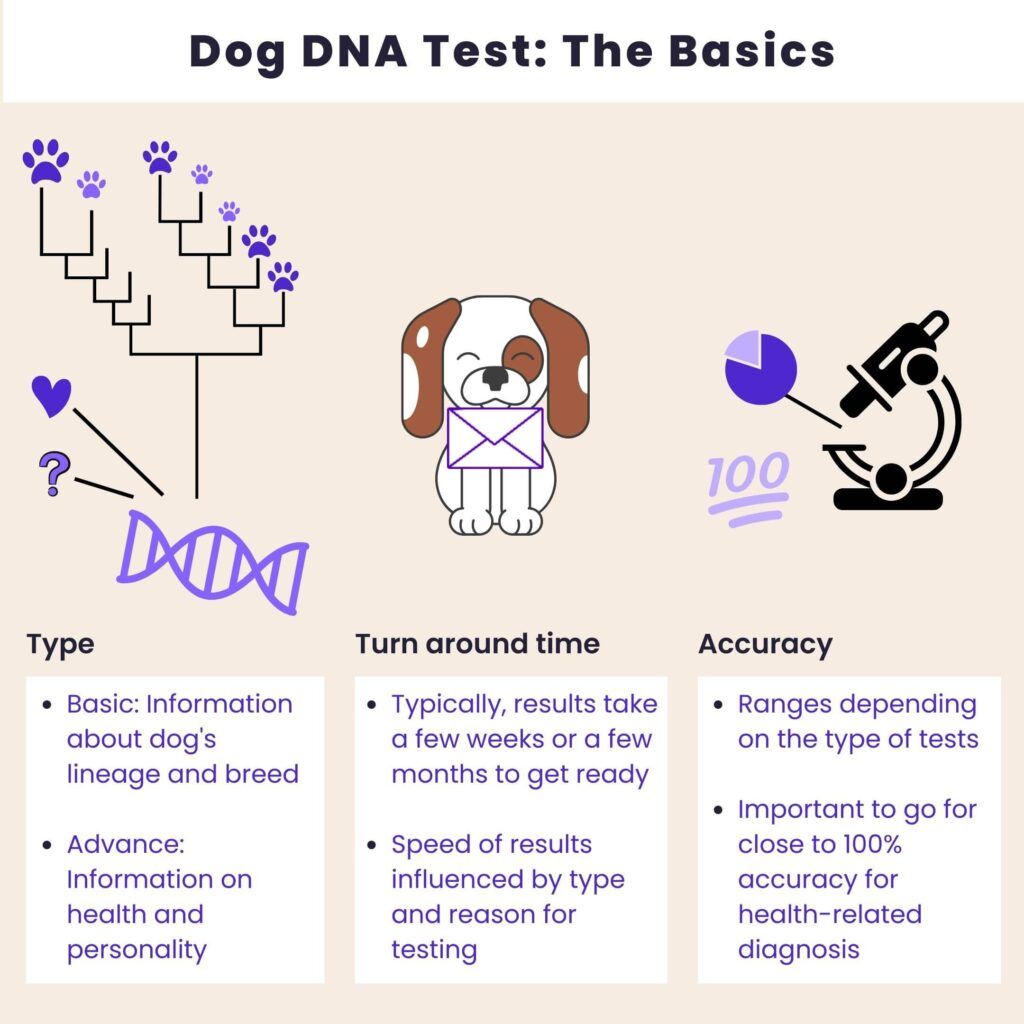
Dog tests help the owners know the specific breeds to allow better care.
Despite the rising popularity of dog DNA testing, only a few companies offer quality services.
The tests can cost anywhere from $60 to $200, based on the knowledge you’re seeking and how deep you want the analysis to be.
Pregnancy DNA tests cost depending on the nature of the test.
The most common types of pregnancy tests include
The cost of a full DNA test, or a whole-genome sequencing test, can vary widely, ranging from $400 to over $1,000, depending on the depth of analysis and the provider.
Some research studies offer free DNA testing if you qualify as a participant, but free consumer testing options are rare and usually limited.
The results can also be too technical and difficult to interpret and understand.
Insurance may cover genetic testing if it is deemed medically necessary, such as for hereditary disease screening, but typically not for recreational or ancestry tests.
Genetic testing can be highly valuable for those seeking insights into health risks, ancestry, or personalized wellness.
Tests for specific hereditary conditions can help with early intervention and personalized health strategies.
However, it is important to understand the difference between clinical and consumer genetic testing.
If you are looking for a diagnosis or a confirmatory yes or no, clinical testing should be your choice.
If your goal is to optimize your health based on certain genetic tendencies, consumer genetic testing can be a very useful tool.
DNA testing has potential drawbacks, such as privacy concerns over data storage and sharing.
Unexpected results can also reveal sensitive information, such as unknown family relationships or health risks, which may be emotionally challenging.
Some tests can be costly, and insurance coverage is generally limited to medically necessary genetic tests, not personal interest or recreational tests.
Further, improper interpretation of results or following recommendations in the report without doctor consultation can harm your health.
Yes, direct-to-consumer companies allow individuals to order their own genetic tests for health, wellness, or ancestry without needing a doctor’s referral.
The pricing of DNA tests varies depending on the type, use, and the company offering the genetic test.
Basic ancestry tests cost around $99, while health and wellness ones can cost as much as $450.
Molecular diagnostic tests can cost anywhere from $100-$1000.
We often talk about being "well," but what does that mean? Do we just mean not being sick? Or is there something more to it than that? Many people mix up the ideas of "health" and "wellness," but they're different. Health is like your body's physical condition – are you disease-free? Wellness is a much bigger picture. It's about your overall well-being, including your physical health, mental and emotional health, social connections, and how you feel about your life. When we understand the little differences between health and wellness, we can make better choices that help us feel good in every way, not just physically. It gives us more control over how we live and how happy we are.
The World Health Organisation (WHO) defines health as "a state of complete physical, mental, and social well-being and not merely the absence of disease or infirmity."
This means that health is not simply the absence of illness.
Good health encompasses physical fitness, mental stability, and everyday societal interactions.
It is a holistic state that allows individuals to live a fulfilling life.
WHO defines wellness as "the optimal state of health for individuals and groups."
Wellness is the active pursuit of good health and a meaningful life.
It encompasses actions and behavior that help you reach your fullest potential.
The two elements of health are:
Wellness is an idea that focuses on a broad spectrum of different elements.
The 12 elements of wellness are:
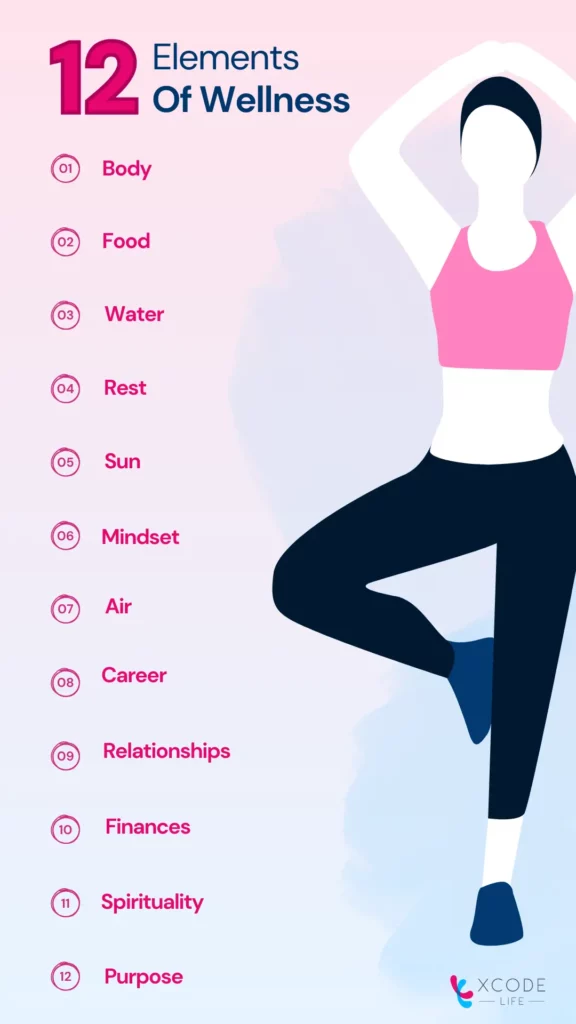
The main difference between health and wellness is the active process of achieving health, which is the goal.
Health is your predisposition to developing certain diseases like type 1 diabetes, hypertension, or cardiovascular diseases.
Wellness is the daily choices you make, like eating a balanced and taking the time out for exercise.
While you cannot always choose health, you can actively pursue wellness.
Here is a comparison between health and wellness:
Well-being is a state of equilibrium or balance in life.
It can be affected by life changes, personal problems, family responsibilities, etc.
Some define well-being as prosperity, happiness, comfort, and good health.
However, these descriptions might not fully describe well-being.
Well-being is more of a personal description of how an individual feels.
Wellness is more intricately connected to your physical and mental health.
In general, wellness practices aim to achieve optimum health through mindful practices and choices in life.
On the other hand, well-being is more connected to your emotional state.
Someone can be extremely ill yet described to be content and happy.
Similarly, someone can be physically and mentally healthy yet not feel balance and fulfillment.
This is the difference between wellness and well-being.
We recommend the Genome Pack! Rated 4.7/5 By Users Like You
This report is not a diagnostic tool but a resource to help you better understand your genetic tendencies. Combined with advice from a healthcare professional and other diagnostic methods, it can guide more informed lifestyle and dietary choices. Xcode Life doesn't ship out DNA kits.
Poor health implies that you are physically unwell and experiencing symptoms associated with diseases.
On the other hand, poor wellness means you don't experience any diagnosable symptoms, yet you don't feel content.
This can be due to a poor diet, stress, lack of sleep, and not feeling supported and cared for.
Over time, poor wellness can eventually lead to poor health.
Health is more focused on physical and mental wellness.
It also indicates an absence of signs and symptoms of diseases.
Well-being is not just about being physically or mentally healthy but also experiencing a general satisfaction in life.
You can not be your best healthy self yet feel completely content and safe in life.
Health is a measurable metric, and well-being is a perception.
Although health and wellness are distinct from each other, both of them go hand in hand.
A foundation of good health is essential to achieve wellness, while wellness helps you become healthier.
For instance, not suffering from any digestive issues is health.
However, to maintain this, you must eat a balanced meal full of whole foods, fiber, fresh fruits, and vegetables, which is wellness.
Health care is all about getting treated for your symptoms.
It encompasses diagnosis, medication, surgery, and rehabilitation for a disease.
Wellness care implies focusing on healthy eating, exercise, and stress management.
The health triangle represents a balance between the three aspects of health:
Health and wellness are often used interchangeably.
But they have two distinct meanings.
While health is more about whether you are free from symptoms of certain diseases, wellness incorporates certain practices that keep you healthy.
Health is mainly concerned with the optimum state of your body and mind.
Wellness involves your career goals, social health, relationships, and overall attitude toward life.
Being mindful about your wellness can, in turn, help improve your health.
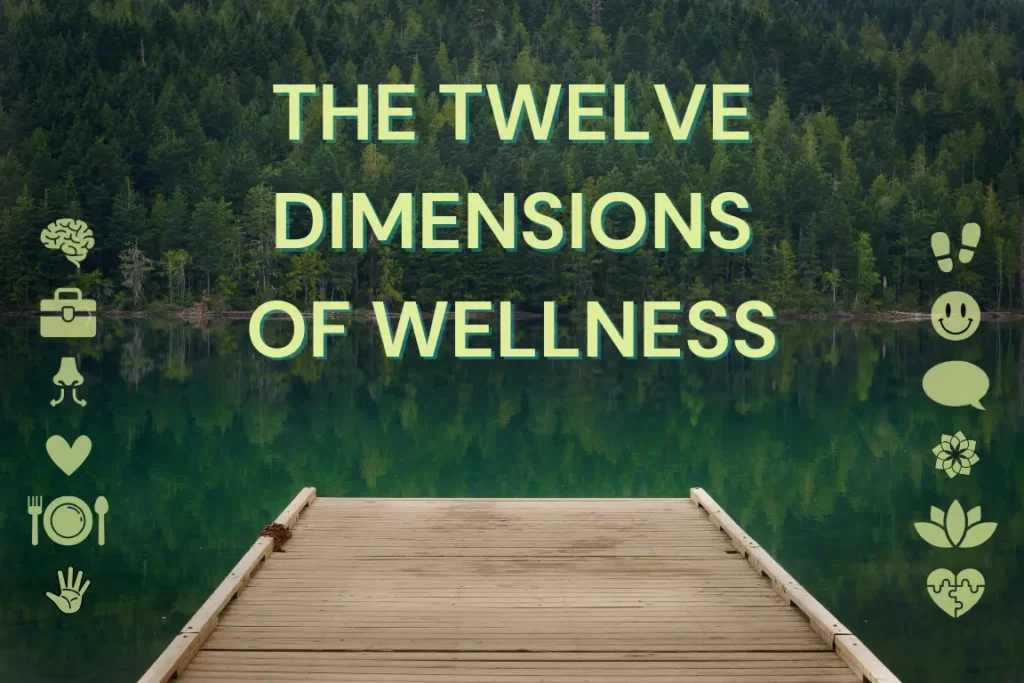
The 12 Dimensions Of Wellness
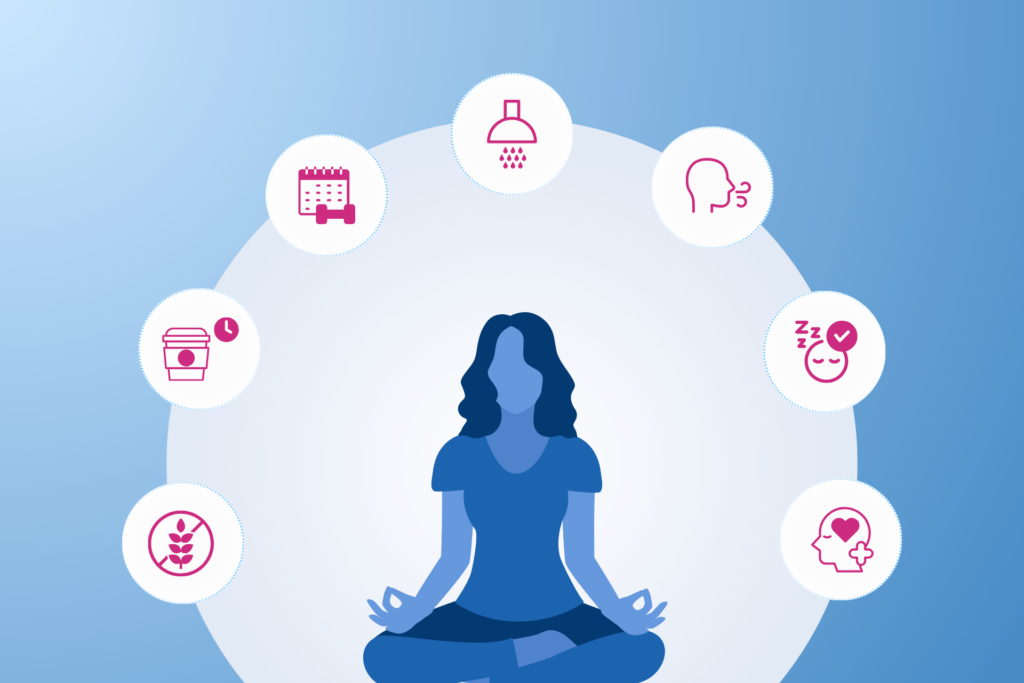
7 Best Biohacks For 2025 To Transform Your Health
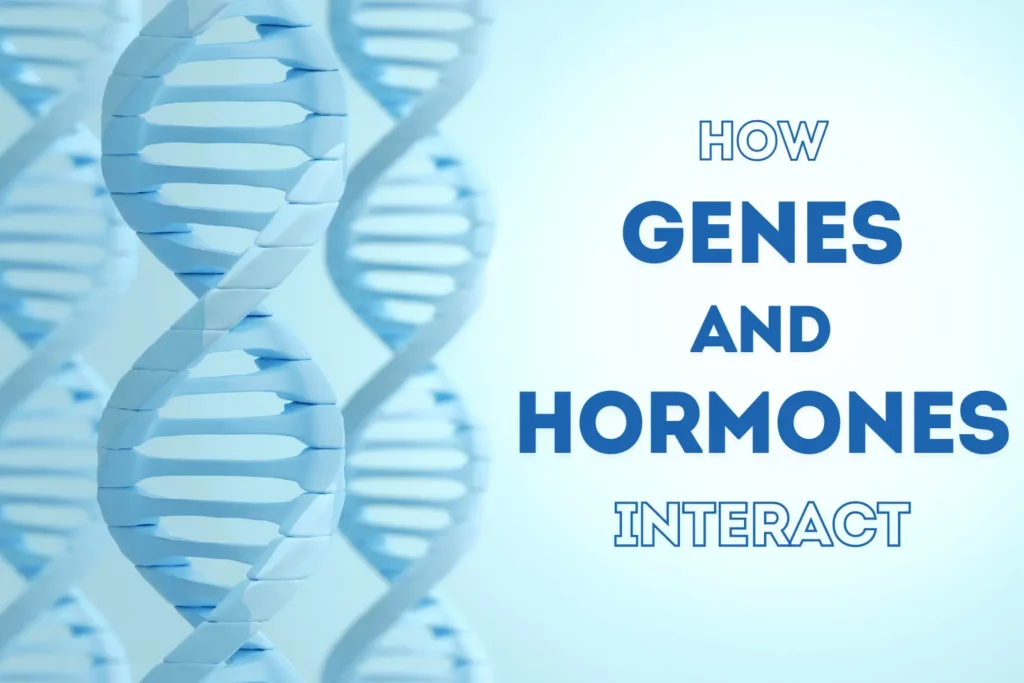
How Genes and Hormones Interact to Influence Your Health